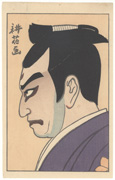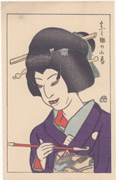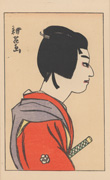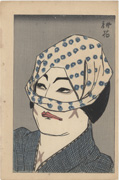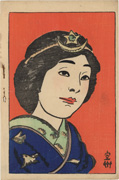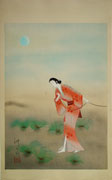Prints in Collection
IHL Cat. #244
IHL Cat. #242 and
IHL Cat. #1972
Kikugorō in the role of
Jūjirō, 1915
IHL Cat. #1964
Yosaburō, 1915
IHL Cat. #2161
IHL Cat. #2162
-intentionally left blank-
Biographical Data
Biography
Yamamura Toyonari 山村豊成 (1885-1942)
Sources: International Fine Print Dealers Association http://www.ifpda.org/content/node/2229; Guide to Modern Japanese Woodblock Prints: 1900-1975, Helen Merritt, University of Hawaii Press, 1992, p. 172; Japanese Wood-block Prints, Shizuya Fujikake, Japan Travel Bureau, 1938, p. 102; Printed to Perfection Twentieth-century Japanese Prints from the Robert O. Muller Collection, Joan B. Mirviss, et. al., Smithsonian Gallery and Hotei Publishing, 2004, p. 28, 81.Born in 1885, in the Shinagawa district of Tokyo, Yamamura Toyonari is best known for his prints andpaintings of Kabuki actors. Yamamura also used the name Yamamura Kōka 山村耕花.
From 1896, he studied with Ogata Gekko (1859-1920), a Meijipainter and printmaker. In 1907, he graduated from the TokyoSchool of Fine Arts (Tokyo Bijutsu Gakko) in Japanese-style painting (nihonga) and exhibited at thefirst government sponsored Bunten show. He also exhibited at the government sponsored Inten and with the Cormorant Society (Ugokai). He was a founding member of the artist group Sango-kai (Coral Society).
Toyonari was very interested in the theatrical arts and historical and genre painting and was a scholar and collector of ukiyo-e. He designed several small actor prints for the magazine New ActorPortraits (Shin Nigao) in 1915. The blocks were carved by Igami Bonkotsu, andseveral other artists contributed to the project, including ToriiKotondo (1900-1976), Ishii Hakutei (1882-1958) and Natori Shunsen (1886-1960). The goal of the project wasto gain attention for the Kabuki theater.
In 1916 he became a member of the Reorganized Japan Art Institute (Saiko Nihon Bijutsuin). Also in 1916, the publisher Watanabe Shozaburo saw one of Toyonari’s paintings at Inten and was soimpressed that he asked Toyonari to create a woodblock print based onthe painting. In 1920, Toyonari began producing his well-knownseries of 12 actor prints, Flowers of the Theatrical World (Rien no hana kagatobi) for Watanabe.Initially, each design was produced in an edition of 150 prints andthey were made in the okubi-e (large head portrait) format. He produced thirty-two prints for Watanabe.
In 1919 he collaborated with Machida Hakuzo and published Compendium of Theatrical Woodblock Prints (Shibai nishiki-e shusei). In the early 20s, Yamamura contributed a design, based on the play Tanba Yosaku, to the woodblock print series Supplements of the Complete Works of Chikamatsu Manzaemon.
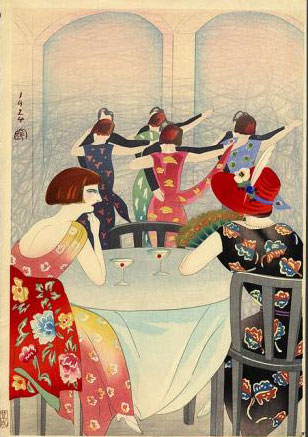
His actor and bird and flower (kacho-ga) woodblock prints were exhibited at the 1930 Toledo Museum exhibition of shin hanga prints.
Yamamura used the art name Kōka mostly for his paintings and Toyonari generally appears on his prints, although both names are occasionally used on his prints.
In recognition of his debt to the carvers and printers that assisted him with his prints, Toyonari stated:
If I had to say so, painters being painters create splendid pictures, and if print masters being print masters convert these faithfully into prints, I think it can be said that these are entirely "creative works". However, if an artist cannot be satisfied with his own work, they should create just the keyblock and color blocks themselves and then leave them in the hands of the specialist blockcutters and printers. I believe that this end result is a creative work. And then, if all is under strict supervision, I feel that in the end it is generally a creative print when done in this manner. Even I at one time tried to "self-draw, self-carve and self-print," but I recognized that the technique was crude, and these days I have stopped doing this altogether...in order to create shin hanga I meet with artisans and while talking it through with blockcutters and printers, I rely on their technique and work diligently with them to produce prints.1
1 Printed to Perfection Twentieth-century Japanese Printsfrom the Robert O. Muller Collection, Joan B. Mirviss, et. al.,Smithsonian Gallery and Hotei Publishing, 2004, p. 28.
